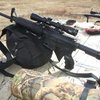I was poking around Hodgdon's reloading data for .223 Remington and saw something odd.
It lists a load using a 55gr Hornady FMJ bullet over 3.2gr of Clays with a velocity of only 1060fps.
What the heck kind of load is THAT?
Most of the "normal" .223 loads use 8-9 times more powder and are 2-1/2 to 3 times higher velocity.
For example: the same type and weight bullet shows using 25.3gr of H335 with a velocity of 2799fps
So what is up with the super light, slow, whimpy load using Clays?
It lists a load using a 55gr Hornady FMJ bullet over 3.2gr of Clays with a velocity of only 1060fps.
What the heck kind of load is THAT?
Most of the "normal" .223 loads use 8-9 times more powder and are 2-1/2 to 3 times higher velocity.
For example: the same type and weight bullet shows using 25.3gr of H335 with a velocity of 2799fps
So what is up with the super light, slow, whimpy load using Clays?
Last edited:

